Green herons are in no way rare or even uncommon in our area. Here at the Museum they arrive in our Wetlands sometime in mid April and usually depart for points south sometime around the end of September. I’ve suspected they’ve nesting here at the Museum for some time but hadn’t found a nest. They can be very secretive about their nests. But, they can also be very conspicuous in their nesting activities.
Tuesday (6/25) as I was walking down the boardwalk with Jennifer (Exhibits) I noticed two visitors watching and taking photos of something in the Wetlands. I assumed that they were taking scenic shots of the Wetlands or perhaps pictures of the turtles grazing in the algae and plankton floating in the water below us, that is, until they pointed out to Jennifer and me the heron standing on a nest in a willow 100 feet or so across the water.
“Whoa! where’d that come from!”

I watched the nest throughout the day, every time that I passed this location on the boardwalk. There were three birds involved with this nest, no squabbles, but three birds on the same branch on the same tree at the same time.
One heron remained on the nest the whole day. Two birds were later seen bringing nest material to another site, another willow tree, across the Wetlands and closer to the Main Wetlands Overlook. Was I witnessing polygamy in Green Herons?
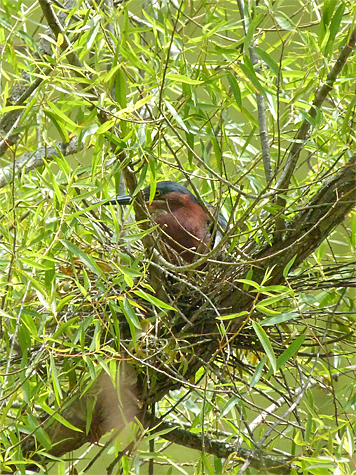
Polygamy exists in certain species of birds in the form of both polygyny and polyandry but I hadn’t heard or read of it in Green Herons. I did find one reference to possible polygamy in Arthur Cleveland Bent’s Life Histories of North American: Marsh Birds “…The presumption is that the two sets [eggs] were laid by the same birds and the interesting possibility of polygamy, or at least of two females laying in one nest…” In this instance the author is talking about two females laying eggs in one nest with one male attending both females. In our case it seems that there are, or may be, two females, one male, but this time two nests.
Of course, I don’t really know what’s going on yet. I only know that I had watched one heron bring nest material to a green heron standing at a nest. I then saw the heron fly off and bring nesting material to another heron, at another nest, in another tree.
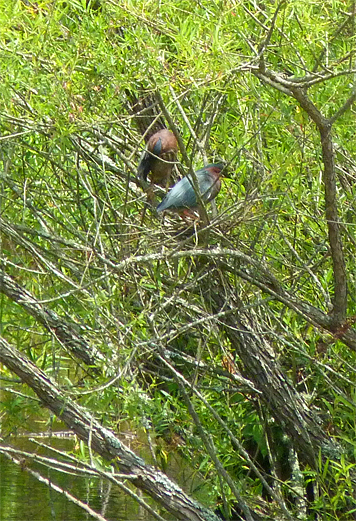
It can get a bit confusing telling one heron from another. I know that there were three birds, two nests in two trees, each with its own “resident” female heron, and one male flying back and forth between the two trees. Perhaps there are actually two pairs and the fourth bird was never visible at the same time as the other three, can’t say for sure. I can say, though, that I’ll be watching them in the days to come.
As I mentioned, one nest is visible from the boardwalk on the right as you descend into Explore the Wild after passing the first platform or landing. I’ll call this nest site one (NS1). The other site, nest site two (NS2) is thirty feet or so from the Main Wetlands Overlook. Both trees can be viewed from the first landing of the boardwalk. The nests themselves are better viewed further down the boardwalk.
By the way, at least one heron was seen frequenting the same tree near the Wetlands Overlook (NS2) on Saturday (6/22). And, in retrospect, one heron had been spending a lot of time at NS1 over the past few weeks too. I assumed it was fishing from the low slung willow trunk that the nest is built on. Apparently the bird was scoping it out for future use as a nest site.

———-Update———-
This morning (6/27) I observed both nests. NS1 was still occupied by a sitting heron. I was able to look into the nest and see at least two eggs. The birds are now committed to this nest.
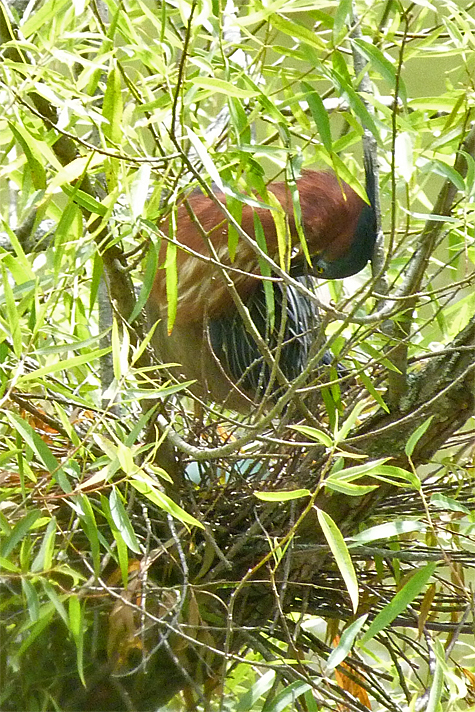
Depending upon what resource you read, Green Herons lay from 2-9 eggs. Unlike the songbirds, incubation starts with the first egg, there may be more to come in this nest. Incubation, again, depending on the reference, is from 17-25 days.
Barring any undue stress or disturbances to the occupants of the nest we should see chicks bouncing about NS1 sometime during the third week in July. If all goes well, the chicks will fledge about three weeks later during the first couple of weeks of August.
The other nest, NS2, showed no activity today but I’m keeping a close watch.
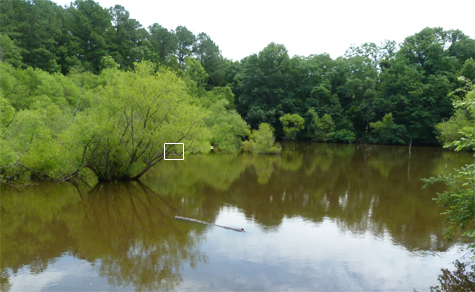
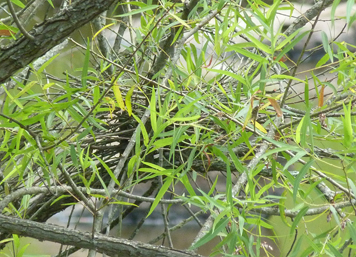
You can bet I’ll be keeping an eye on what these herons are up to in the next few months. And of course, I’ll be letting you know what’s happening right here, in this Journal.
I know we have had green herons here “forever”, but have we (they) ever had offspring here?
As I mentioned at left, I’ve suspected that they’ve nested here before but have never found a nest. I’ve seen herons in juvenal plumage, as indicated in a recent post: /2013/06/03/green-heron-2/ (scroll down to last photo).
Whether they have nested here in the past or not, these nests (if both are used) are unique in that they are easily viewed by visitors which can be a great teaching and learning experience.